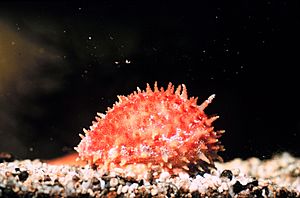Cowry facts for kids
Quick facts for kids Cowry |
|
|---|---|
 |
|
| Cypraea caputserpentis L., 1758; a common cowry in rocky areas. | |
| Scientific classification | |
| Kingdom: | |
| Phylum: | |
| Class: | |
| Subclass: |
Orthogastropoda
|
| Order: |
Sorbeoconcha
|
| Superfamily: |
Cypraeoidea
|
| Family: |
Cypraeidae
|
| Genus: |
Cypraea
|

Cowry (also spelled cowrie) shells come from a type of marine snail called a sea snail. These snails belong to the family Cypraeidae.
You can mostly find them in warm, tropical parts of the world. There are about 200 different kinds, or species, of cowry snails.
Contents
What is a Cowry Shell Like?
The shell of a cowry is almost always very smooth and shiny. It has a long, narrow opening that looks like a slit. All types of cowries have a bright, porcelain-like shine. Many also have beautiful, colorful patterns. When the snail is alive, its shell is covered by a slippery part called a mantle.
Cowry shells can be very small, about 5 mm (1/5 of an inch). Some, like the tiger cowry, Cypraea tigris, can grow quite large, up to 15 cm (6 inches) long.
How Do Cowries Protect Themselves?
Cowry shells are very slippery, which makes them hard for most animals to grab. The narrow, toothed opening of the shell also makes it tough for predators to get inside. However, cowries can still be hunted by some animals:
Who Eats Cowries?
- Some tropical crabs can break the top part of a cowry shell.
- Certain cone snails, like Conus textile, can inject venom into the cowry's body. The cone snail then stretches its stomach into the cowry shell through the slit to eat the snail.
- Some octopuses can make a small hole in the shell. They use a special tooth and a strong liquid to do this. Then, they inject venom to kill the snail inside.
How Cowries Are Grouped (Taxonomy)
For almost 200 years, all cowry species were placed in just one genus, called Cypraea. But in 2002, scientists decided to divide cowries into many different genera. This helps to better organize and understand the different types of cowries.
How People Have Used Cowry Shells
Cowry shells have been used for many things throughout history.
Cowries as Money
Cowries, especially the Cypraea moneta species, were used as currency (money) in places like Africa and China. For example, the money in Ghana, called the Ghanaian cedi, is named after cowry shells. Sometimes, copies of the shells were also used for trade.
Cowries as Jewelry and Charms
People also wear cowry shells as jewelry or use them as decorations. They are often seen as symbols of womanhood, fertility, birth, and wealth. Many people simply enjoy how shiny and porcelain-like the shells look.
Other Uses for Cowries
In the past, cowries were used to help darn socks. A sock heel would be stretched over the shell. The ridges on the cowry made it easier for a needle to go under the fabric.
The Ojibway people, who are Native Americans in North America, used cowry shells in their ceremonies. The Whiteshell Provincial Park in Manitoba, Canada, is even named after this type of shell. It's a bit of a mystery how these shells got so far inland, away from the ocean. Some stories say they were found in the ground or washed up on lake and river shores. Finding cowry shells so far inland might mean that ancient tribes had a large trade network long ago.
Related pages
Images for kids
-
A drawing from 1742 showing shells of the money cowrie, Cypraea moneta
See also
 In Spanish: Cauri para niños
In Spanish: Cauri para niños





